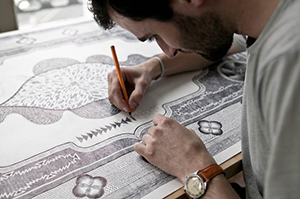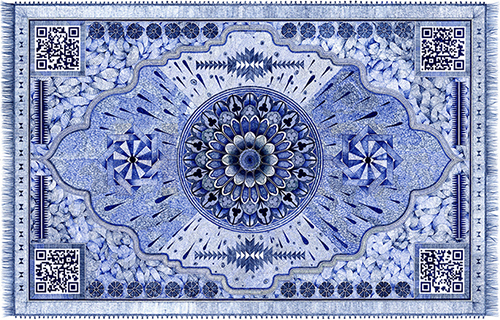PARIS, FRANCE. Carpets painted with Bic pens? Sounds like a crazy idea. But the Paris-based design studio Joe & Nathan has made it a reality.
Founded by art director Jonathan Bréchignac, Joe & Nathan usually dedicates itself to digital design. Yet their last piece of work is completed with the most simple of objects: paper, blue Bic pens and UV ink. With these tools, Jonathan has drawn a series of Muslim prayer carpets. Painstakingly detailed, the carpets showcase different patterns that come together to create a unique whole using only one Bic pen: the “Less is more” concept.
His last work, The Blue Carpet, is inspired by different types of art, including French, Roman, traditional Japanese, Native American, Mexican, as well as military camouflage and animal patterns.
Here, he speaks to ROOSTERGNN about this project, currently on view at the Villa Empain at the Boghossian Foundation in Brussels.
Your previous work has more to do with digital design than with classic drawing. How did you decide to work with Bic pencils?
Jonathan Bréchignac: I work in the fields of graphic design (digital, editorial…) and at the same time fine arts. I feel comfortable with being both: designer and artist. There is no real separation between the two in my work. Repeating patterns all day long with a pen is good to empty my mind and is like meditation, but it is more physical than we can think! So the alternation of rhythm is good. The reason why I choose Bics is that they are the most universal and common pencils ever. I love the idea of using something anyone thinks knowing. Everybody has already doodled during a phone call with them. I only repeat the doodles for hours and on bigger sheets. I try to push their limits.
Other Bic-artists usually draw portraits or landscapes. Why a Muslim carpet?
The subject of the carpet was at first a pretext to make big drawings on which I would work day after day (I am deeply fascinated by ancient arts masters or craftsmen who could spend years or even their life on the same piece). I was also interested in patterns, geometrical shapes and fabric. It is well known that a part of the Islamic art is non figurative and that the meaning comes through geometry. I realized that it could be interesting to treat them as Muslim praying carpets, giving a bigger dimension and more sense to the drawings. This work talks about the mix of civilizations, especially around the Mediterranean sea and is questioning our relation to the East. The subject of the carpet is as universal as the Bic pen.
It is an important artefact in all the civilizations, not only to beautify the space. It inspires also the ideas of fantastic (flying carpet, 1001 nights…), as crafts and savoir-faire. I thought it was a noble subject for my big drawing.
Also, I found interesting to pervert the use of this object: to draw hair by hair a full sized carpet on a sheet that none will never be able to use as a carpet.

Detail of The Blue Carpet and some Bic pens used in its creation | Jonathan Bréchignac
The Blue Carpet, your “analogue drawing” so to say, won a third price in the FUBIZ Awards 2012. What did this mean for you as an artist?
Even if it is not an end in itself, receiving such an award is still very nice and encouraging. I was very honored thousands of people have seen and voted for my work. Since then, I got many interview from different countries, such as China, USA, Brazil, Ukraine, Europe… And I was approached by the Boghossian foundation, in Brussels, where The Blue Carpet is currently shown.
You say the concept of the Blue Carpet is “Less is more.” But if you look closely, the details of the drawing are not really “less.” How do you reconcile this conflict?
Obviously the blue carpet is visually not minimalistic. It is maybe a shift in meaning but there is the will of doing more with the less. I try to use the most simplistic things to maximize the result. Only a pencil, a big sheet of paper and time are the ‘tools’ needed to make the drawings that you’ve seen.
You used different types of art: French, Roman, traditional Japanese, Native American, Mexican, as well as military camouflage and animal patterns. Which one is the most influential in The Blue Carpet?

The artist working on The Carpets series| Jonathan Bréchignac
There is not one influence that comes before another in the carpet. The blue carpet, like the others I previously made, is a whole making sense exactly by the mix of all the influences. So the point is not to bring out one in particular. However I can list some influences: the central medallion was inspired by the great rose window of Notre-Dame de Paris, the brighter areas with dots are inspired by ostrich leather or sea urchin, the stars comes from classic oriental geometry… I mix all kind of patterns, the inspiration comes from different types of art which you already mentioned. The QR codes link to a website dedicated to the series of carpets, which confers to these pieces a 2.0 aspect and an extension on the web.
This mixture creates a mix of civilizations and religions that endows them with a new meaning. Is this peaceful coexistence of cultures a hope you want to share with your viewers people?
It is not my pretension. I just wish that my work touch the people or at least that they will enjoy the result of this long-term work. But if in addition it can also make them think about the enriching connections between cultures and the importance of the ‘living together’ in our globalizing world, etc.
Your piece of work has become part of the private collection of HH Sheikh Sultan Bin Mohammad Al Qasimi. Could you tell us the story of this experience?
I received once an email from UAE government department of culture inviting me to participate to the Islamic arts festival held in Shajah. I accepted the invitation for a ‘live drawing workshop’ in a big art center, at the school of arts of Shajah, and an exhibition of my carpets at the festival. I was the only non-arabic and non-Muslim artist. I received a warm welcome and I felt a lot of curiosity. It was really interesting to be there. I met other artists from Iran, Turkey and Lebanon, it was enriching.
Are you going to continue drawing with Bic pencils, or do you prefer digital design?
Of course I will continue to make new carpets. I have the project to finish the series, 2 other are now on the go. The Bic company is very interested in this work and now I have a common project with them.
***
Jonathan Bréchignac is an art director based in Paris. In his design studio Joe & Nathan, he is specialized in art direction, print & publishing, visual identities, web design, typography, illustration and design strategy. Jonathan has been awarded with a Fubiz Award 2012 and exhibited his work in Brussels and Lebanon, among others.
The Blue Carpet will be on view at the Villa Empain at the Boghossian Foundation in Brussels until February 9th, 2014.

